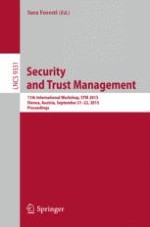2015 | OriginalPaper | Buchkapitel
SUDUTA: Script UAF Detection Using Taint Analysis
verfasst von : John Galea, Mark Vella
Erschienen in: Security and Trust Management
Aktivieren Sie unsere intelligente Suche, um passende Fachinhalte oder Patente zu finden.
Wählen Sie Textabschnitte aus um mit Künstlicher Intelligenz passenden Patente zu finden. powered by
Markieren Sie Textabschnitte, um KI-gestützt weitere passende Inhalte zu finden. powered by
